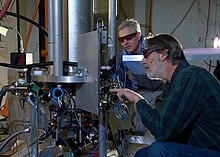
The caesium standard is a primary frequency standard in which the photon absorption by transitions between the two hyperfine ground states of caesium-133 atoms is used to control the output frequency. The first caesium clock was built by Louis Essen in 1955 at the National Physical Laboratory in the UK[1] and promoted worldwide by Gernot M. R. Winkler of the United States Naval Observatory.
Caesium atomic clocks are one of the most accurate time and frequency standards, and serve as the primary standard for the definition of the second in the International System of Units (SI), the modern metric system. By definition, radiation produced by the transition between the two hyperfine ground states of caesium-133 (in the absence of external influences such as the Earth's magnetic field) has a frequency, ΔνCs, of exactly 9192631770 Hz. That value was chosen so that the caesium second equaled, to the limit of measuring ability in 1960 when it was adopted, the existing standard ephemeris second based on the Earth's orbit around the Sun.[2] Because no other measurement involving time had been as precise, the effect of the change was less than the experimental uncertainty of all existing measurements.
While the second is the only base unit to be explicitly defined in terms of the caesium standard, the majority of SI units have definitions that mention either the second, or other units defined using the second. Consequently, every base unit except the mole and every named derived unit except the coulomb, ohm, siemens, gray, sievert, radian, and steradian have values that are implicitly defined by the properties of the caesium-133 hyperfine transition radiation. And of these, all but the mole, the coulomb, and the dimensionless radian and steradian are implicitly defined by the general properties of electromagnetic radiation.
- ^ L. Essen, J.V.L. Parry (1955). "An Atomic Standard of Frequency and Time Interval: A Caesium Resonator". Nature. 176 (4476): 280–282. Bibcode:1955Natur.176..280E. doi:10.1038/176280a0. S2CID 4191481.
- ^ Markowitz, W.; Hall, R.; Essen, L.; Parry, J. (1958). "Frequency of Cesium in Terms of Ephemeris Time". Physical Review Letters. 1 (3): 105. Bibcode:1958PhRvL...1..105M. doi:10.1103/PhysRevLett.1.105.
